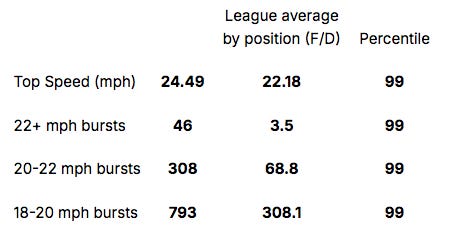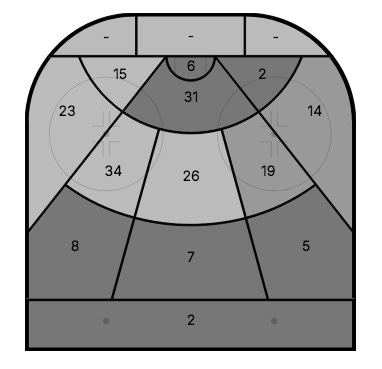Two bridge deals. Rumored frustration over his role. The marriage between Martin Necas and the Carolina Hurricanes was never going to last. In late January, he was finally dealt to Colorado and has since earned more accolades in three months than he’d seen in his entire career.
Riding shotgun next to Nathan MacKinnon will have that effect.
He’s no passenger, though, and there’s reason to believe he can provide similar impact away from the superstar center at 5-on-5—if not in raw production, then certainly in influence.
A recent move to Brock Nelson’s wing is demonstrating the potential that’s been simmering beneath the surface. Let’s dig in.
Transition
MacKinnon had this to say about Necas in February:
“I think we have a similar style of game. We both like to carry it off the rush, we're both righties. I think we think both similar, so we can imagine where each other would be on the ice.”
His assessment is fair, but he viewed these parallels through a positive lens when one could argue they hamstrung the Czech dynamo. Their shared thought processes and habits led to instances where they crowded rather than complemented each other. There wasn’t enough puck to go around, which lowered the ceiling of a high-usage, transition-heavy winger like Necas.
Did he and MacKinnon form a great duo nonetheless? Yeah, mostly. On separate units, Colorado could unleash a great top six. It doesn’t take many viewings to notice his line-driving ability:
The trait that leaps off the screen is his skating. While this isn’t news to anyone, it bears repeating that he’s insanely fast:

With that said, he’s a different type of burner compared to MacKinnon. Not quite as explosive (or angry) out of the blocks, which is why the Dogg has clocked far more 22+ mph bursts this season, yet Necas actually has the edge in long speed (2nd-fastest max speed recorded in 2024-25). If you let him gather momentum and catch in stride—a scenario that Jared Bednar’s system is built to produce—you might already be cooked.
Hell, he doesn’t even need a quality first pass to dust you:
The urgency with which defenses must deny his touches intensifies when you consider how early he makes himself available, swinging low to present a viable target and blazing through the NZ in a flash.
Not content with screaming down the flanks, Necas uses his nose for middle ice to elicit scrambles on entry too. This is where the magic happens. As counterintuitive as it sounds, he helps Colorado play fast by easing off the gas and attacking the gap he’s created between straggling backcheckers and deer-in-headlights blueliners. That direct albeit somewhat deliberate path to the guts of the DZ prevents defenses from finding their bearings.
Much like educated boxers know how to manage distance, he’ll dangle a carrot in front of D-men and snatch it back the moment he senses any hint of over-commitment:
In the clip above, Necas realizes that a forward (Max Domi, TOR 11) is defending him. Green light for some 1-on-1 action. He proceeds to:
Carry Domi to a depth that forces the Leafs winger to respect a potential net drive.
Time his inside cut with his counterpart’s crossover (i.e. feet aren’t set).
Underhandle (blade off puck) to dull Domi’s last-ditch stick check.
Drop to Artturi Lehkonen (COL 62) —> speed differential —> slot opportunity.
The 26-year-old is at his absolute best when he’s slicing across defenders’ hands instead of trying to dangle through their frame. On the back of his timing and sheer velocity, his sudden cuts carve out ample daylight for himself and his teammates.
Watch how his east-west elusiveness sows mass confusion near the blue line:
Don’t expect Necas to spring teammates via short link-ups. He can complete the occasional deep ball but primarily wants to be, well…the primary puck-handler.
It’s hard to fault him for that. Although he’s not a stout defender, it’s not like he’s cherry-picking the whole time either (e.g. William Nylander). He’s just aware of his gift for blowing past the entire defense. He’s a home run threat on every reception.
Better yet, he’s HUNGRY for them:
On this set faceoff play, Necas kicks the puck back to Samuel Girard (COL 49) and immediately starts churning his legs because he recognizes the soft ice between the Kings’ high forwards (LA 22 and 14). There’s a path to the slot available strictly to the highest-caliber skaters. He qualifies, and he knows it. NZ draw —> Avalanche scoring chance in eight seconds flat.
Is he a competent distributor and trailer in transition? Sure. He remains most valuable to Colorado as his line’s main puck-carrier. The tip of the spear. His wheels instill fear in defenders’ hearts.
Seeing as MacKinnon offers the same dimension, spreading it onto two units clears the floor for these speed demons while forming a lethal top six. A Hart Trophy front-runner on one line. An ice-tilting winger and goal-scoring center on the next. This is the stuff of matchup nightmares.
Offense
While Nelson was a steady offensive contributor with the Islanders, he isn’t a play-driver by any stretch. He’s a rangy center who thrives on spacing, quick touches and finish.
In other words, getting the best version of him will require a puck-dominant, table-setting winger.
An inconsistent and error-prone Jonathan Drouin won’t suffice. Nichushkin and Lehkonen are shoot-first two-way wingers. Not setup men. Necas is the obvious candidate. We’ve covered how his transition game supplies linemates with plenty of plus touches, but he’s more than a rush merchant. His in-zone offense is perhaps a tad underrated:
Necas’ dual-threat arsenal skews pass-first, and he leans further into his playmaking once his team establishes OZ control. With less space to fire his lasers, he focuses on feeding his teammates through the jaws of the defense. That should play nicely with Nelson’s marksmanship.
Here’s an example of his preference for dishing:
Off an OZ rim, his swift pickup places both Simon Edvinsson (DET 77) and Justin Holl (DET 3) on the weak side. He has room to circle above the goal line and test the Red Wings in tight. Instead, he spots Lehkonen for a superior look, as the pass to a central location forces Petr Mrazek (DET 34) to push off his post and therefore open up.
Give Nelson (a 3-time 30-goal man) a healthy supply of slot chances and see what happens.
Due to Necas’ tendency to hold the puck for a beat prior to attacking, his playmaking potency falls shy of the best in class (Nikita Kucherov). However, his eagerness to pass and sublime touch make him a stellar distributor all the same:
The instant he decides to dish, there’s virtually no window he can’t exploit. He’ll stare down defenders in decent position and whistle pucks through their triangle or float saucers over their stick as though they don’t even exist. The skill demanded in these clips is remarkable, yet he delivers it in his sleep. His 13th-ranked assist tally (54 in 76 games) isn’t some happy accident.
So…get in his grill, right? Disrupt his rhythm. Well, the Habs will tell you that’s a more complicated solution than you think:
Necas boasts incredibly quick feet, and he weaponizes them to extend his playmaking runway when opponents attempt to bear down on him. Those sudden cuts we witnessed on entry assume a more compact but no less effective shape in close quarters. As you can see above, he can also chain them together to put defenders in the spin cycle.
His strength on the puck leaves something to be desired, but he can turn a sliver of space into an ocean of separation.
And that’s merely the passing side of the equation. We can’t ignore the fact that his shooting and scoring rates are up since the trade. Moreover, his bids are difficult to anticipate:

He’ll dash uphill in Jesper Bratt-like fashion to filter his wrister through traffic. He’ll post up on his off wing for a hellacious one-timer from mid-range. He’ll sneak to the backdoor on the PP. Speaking of which, a Necas-Nelson duo at EV doesn’t remove the Necas-MacKinnon connection from the man advantage or 6-on-5 settings.
The winger’s versatility adds extra spice to the PP and can help trigger more movement from MacKinnon (both are capable left-flank options). Factor in Cale Makar’s brilliance from the point and a dangerous bumper, and Colorado’s PP1 can score every which way.
Pairing Necas and Nelson together at 5-on-5 while stacking the top PP unit provides the Avalanche with the best of both worlds.
The Necas-Nelson partnership may run into growing pains over the remainder of the regular season. It’s been a tumultuous year after all. Bednar should set the blender aside and invest in their rapport.
Even if the winger’s production tapers off, outpacing Necas-MacKinnon isn’t the goal. For a team whose offense faltered when it mattered most in the past two postseasons (2.71 G/PG vs. SEA and 2.50 G/PG vs. DAL), this is about extracting full value out of Nelson. Depth. Balance. Relentless pressure. When one supernova skates off the ice, another hops on.
Imagine trying to defend that for 60 minutes in a best-of-seven series.





I’m sharing this with Pete DeBoer just in case. :)
Great take, fully agree. The 2nd line has been noticeably dangerous with Necas. The PP a step above both top lines, with players more evenly spread across them too. Bednar has to be very happy with his options here now.